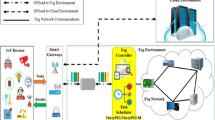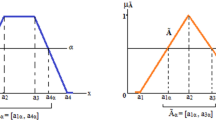Abstract
Estimating the time required for simulating a factory online is a crucial topic in manufacturing. However, this topic has rarely been discussed. A fuzzy back-propagation network (FBPN) approach for estimating the workload of a simulation task according to the required simulation time is proposed in this paper. In the proposed FBPN approach, tasks for which simulation times cannot be effectively estimated are considered as outliers and excluded, and therefore, more appropriate lower and upper bounds on the simulation time can be set. Thus, the ranges of all simulation times can be efficiently narrowed; however, this decrease is achieved at the expense of a slight decrease in the hit rate, which is still tolerable. A real case containing data of 90 simulation tasks was used to validate the proposed methodology. In addition, two existing FBPN methods, the adaptive-network-based fuzzy inference system method and the Chen (Comput Ind Eng 66:834–848, [2013]) method, were applied to these tasks for comparison. The experimental results showed that the proposed methodology was superior to the two existing FBPN methods in estimating precision and accuracy.










Similar content being viewed by others
References
Zott C (2003) Dynamic capabilities and the emergence of intraindustry differential firm performance: insights from a simulation study. Strateg Manag J 24(2):97–125
Chen T (2014) Strengthening the competitiveness and sustainability of a semiconductor manufacturer with cloud manufacturing. Sustainability 6:251–268
Fujimoto RM (1987) Performance measurements of distributed simulation strategies. Defense Technical Information Center, Fort Belvoir
Amin MB, Vinnakota B (1999) Data parallel fault simulation. IEEE Trans Very Large Scale Integr Syst 7(2):183–190
Majumdar A, Ochieng WY (2007) Factors affecting air traffic controller workload: multivariate analysis based on simulation modeling of controller workload. J Transp Res Rec J 1788:58–69
Meng W, Zhao G (2014) Effects of key simulation parameters on conical ring rolling process. Procedia Eng 81:286–291
Horikawa SI, Furuhashi T, Uchikawa Y (1992) On fuzzy modeling using fuzzy neural networks with the back-propagation algorithm. IEEE Trans Neural Netw 3(5):801–806
Chen T (2003) A fuzzy back propagation network for output time prediction in a wafer fab. Appl Soft Comput 2(3):211–222
Jang JS (1992) Self-learning fuzzy controllers based on temporal backpropagation. IEEE Trans Neural Netw 3(5):714–723
Chen T, Lin YC (2011) A collaborative fuzzy-neural approach for internal due date assignment in a wafer fabrication plant. Int J Innov Comput Inf Control 7(9):5193–5210
Chen T (2013) An effective fuzzy collaborative forecasting approach for predicting the job cycle time in wafer fabrication. Comput Ind Eng 66:834–848
Zimmermann HJ (1991) Fuzzy set theory and its applications. Kluwer Academic Publishers, Boston
Tesauro G (1995) Temporal difference learning and TD-Gammon. Commun ACM 38(3):58–68
Hans Raj K, Sharma RS, Srivastava S, Patvardhan C (2000) Modeling of manufacturing processes with ANNs for intelligent manufacturing. Int J Mach Tools Manuf 40(6):851–868
Bonnans JF, Gilbert JC, Lemaréchal C, Sagastizábal CA (2006) Numerical optimization: theoretical and practical aspects. Springer, Berlin
Benardos PG, Vosniakos GC (2002) Prediciton of surface roughness in CNC face milling using neural networks and Taguchi’s design of experiments. Robot Comput Integr Manuf 18(5–6):343–354
Sukthomya W, Tannock J (2005) The optimization of neural network parameters using Taguchi’s design of experiments approach: an application in manufacturing process modeling. Neural Comput Appl 14(4):337–344
Chen T (2009) A fuzzy-neural knowledge-based system for job completion time prediction and internal due date assignment in a wafer fabrication plant. Int J Syst Sci 40(8):889–902
Jang JS (1993) ANFIS: adaptive-network-based fuzzy inference system. IEEE Trans Syst Man Cybern 23(3):665–685
Chen T, Romanowski R (2013) Precise and accurate job cycle time forecasting in a wafer fabrication factory with a fuzzy data mining approach. Math Probl Eng 2013:1–14
Acknowledgments
This study is financially supported by the Ministry of Science and Technology, Taiwan.
Author information
Authors and Affiliations
Corresponding author
Rights and permissions
About this article
Cite this article
Toly Chen, TC. Fuzzy back-propagation network approach for estimating the simulation workload. Neural Comput & Applic 27, 1707–1715 (2016). https://doi.org/10.1007/s00521-015-1967-z
Received:
Accepted:
Published:
Issue Date:
DOI: https://doi.org/10.1007/s00521-015-1967-z




